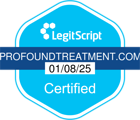To be in a recovery program means that you will adhere to and work the Twelve Steps. Intrinsic to your program is the idea that it is anonymous. Indeed, the final letter of the abbreviation of most, if not all, fellowships that follow the Twelve Steps as a formula to help people recover from various forms of addictive, compulsive, or other behavioral problems is “A.” That letter, of course, stands for “Anonymous.” But what does that mean in the context of recovery?
As support for the name and purpose of the organization, the Twelve Traditions incorporate the concept of anonymity:
Tradition Eleven — Our public relations policy is based on attraction rather than promotion; we need always maintain personal anonymity at the level of press, radio, and films.[1]
Tradition Twelve — Anonymity is the spiritual foundation of all our traditions, ever reminding us to place principles before personalities.[2]
Confidentiality is a necessary element in the process of recovery, both inside the organization and outside. Recovery, by its very nature, is an intensely personal task.[3] People who are going through the recovery process generally experience feelings of hope for their future, optimism and a firm belief in themselves and their ability to persevere, as well as fear, stigma, embarrassment or shame for what they’ve done. The anonymity of the group allows them to openly express, without fear of unwanted exposure or public judgment, anything they wish to disclose and seek help for. Members regularly go to meetings with other members who share their form of addiction. They identify themselves to the other members, preserving anonymity, in this manner: “Hi, I’m Ignatz and I’m an alcoholic.” Anonymity protects the members’ privacy in their pursuit of sobriety and ensures that everyone in the meeting is treated as being of equal value. It also affords the individual the personal opportunity and choice to reveal his or her addiction to whomever they wish at the time of their choosing.
Key to the public’s ongoing trust in Twelve Step groups is the knowledge and faith in their commitment to the principles of discretion and anonymity. There are those who would disagree. Generally their opinion is that the concept of anonymity is archaic. In “Challenging the Second ‘A’ in A.A.,” writer David Colman starts by saying, “I’M David Colman, and I’m an alcoholic.”[4] In his article, he quotes a professor of philosophy at the University of Missouri at Kansas City who revealed his own experience getting sober with A.A., who said, “I think it’s extremely healthy that anonymity is fading.” He cites examples of people who posted pictures taken at A.A. meetings on their Facebook pages thereby involuntarily outing other attendees, other writers of memoirs detailing their experiences in recovery, and even politicians who have traded on their sobriety:
Still, others have embraced the path of full disclosure and been rewarded. Since becoming sober in 2006, Patrick J. Kennedy, the former Rhode Island congressman and a son of the late Edward M. Kennedy, has acknowledged that he attends A.A. meetings while also actively campaigning for legislation to make addiction be held to the same standard of insurance coverage as other mental health issues. (The Mental Health Parity and Addiction Equity Act, included as a rider on the Troubled Asset Relief Program, was signed into law in October 2008.)
“The personal identification that Jim and I brought to this issue as recovering alcoholics gave us a place from which to speak about this,” Mr. Kennedy said, referring to former Representative Jim Ramstad, Republican of Minnesota, his co-sponsor of the bill (and for a time, his sponsor in A.A.). “Stigma here is our biggest barrier, and knowledge and understanding are the antidote to stigma.”[5]
What he ignores, and what is central to an addict who is trying to recover is that the decision to reveal oneself as an addict or as a recovering addict is a personal one. Nobody has the right to expose another person’s personal issues. The founders of A.A. understood this. They incorporated this concept into the program they created. Clearly, it works.
[1] Alcoholics Anonymous, Twelve Steps and Twelve Traditions (New York, N.Y.: The A.A. Grapevine, Inc. and Alcoholics Anonymous Publishing (now known as Alcoholics Anonymous World Services, Inc.), 1952, 1953, 1981), p. 180.
[2] Alcoholics Anonymous, p. 184.
[3] Repper, Julie, and Rachel Perkins. Social Inclusion and Recovery: A Model for Mental Health Practice. Edinburgh: Baillière Tindall, 2003.
[4] Colman, D. (2011, May 6). Challenging the Second ‘A’ in A.A. The New York Times. Retrieved from http://www.nytimes.com
[5] Colman, D.











